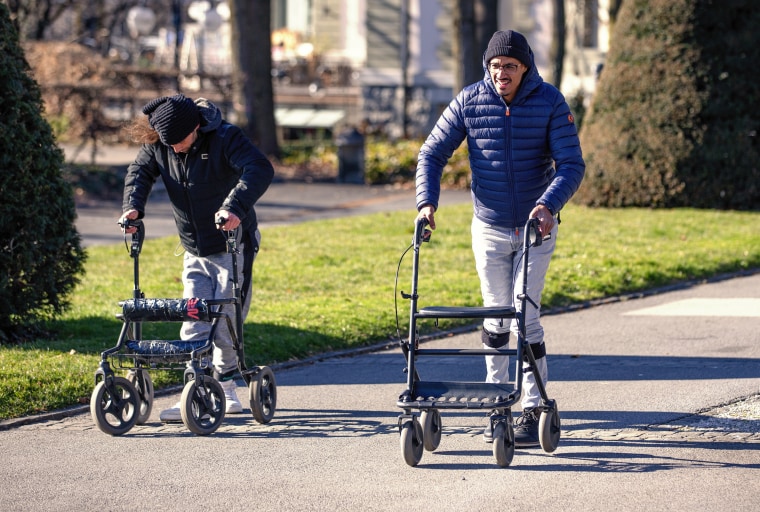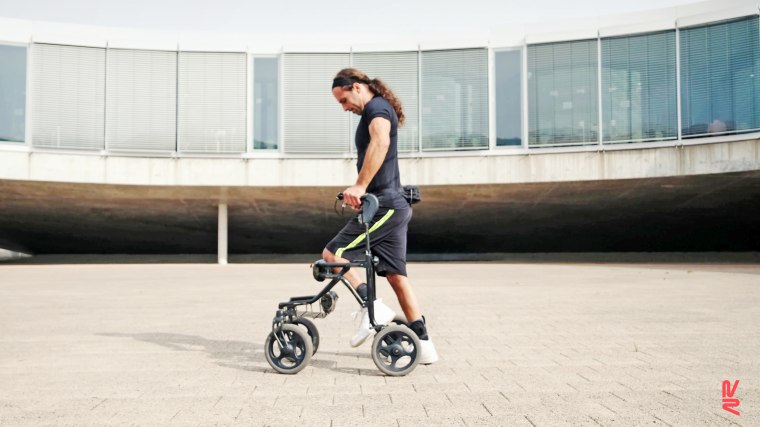After a motorcycle accident in 2017, Michel Roccati, 30, wasn’t expected to be able to stand on his own ever again, let alone walk. But on a sunny day in 2019, at the Lausanne University Hospital in Switzerland, he walked across a promenade, thanks to the help of perfectly timed electrical impulses in his spine.
Two years after his injury, Roccati had been one of three men with paralyzing spinal cord injuries to enroll in a trial that allowed them to test-run a prototype of a modified medical device that could help people like them regain movement.
The surgically-implanted device, called a spinal cord stimulator, has been used for decades to treat chronic pain. Scientists modified the technology, which sends electrical signals to select areas of the spinal cord to help people who are paralyzed due to a spinal cord injury stand and even walk. (In people without spinal cord injuries, these electrical signals are sent by the brain to the spinal cord when a person wants to move their limbs.)
In a study, results of which were published Monday in Nature Medicine, Swiss researchers used a version of the device to do just that.
Within hours of starting therapy with the device, all three men could move their legs. After just one day of practicing specific activities, they were able to stand, walk with the help of a walker, cycle and swim. With the help of therapy, they were also able to do all that outside the lab, in the real world.
“It’s not easy and it takes a lot of work, but it’s a dream for most people in this group,” said Dr. Jocelyne Bloch, an associate professor of neurosurgery at Lausanne University Hospital, who co-authored the research.
Instead of targeting pain receptors like traditional spinal cord stimulators, the novel device uses personalized electrodes that target the nerves in the spine that control leg and trunk movements.
According to Dr. Eellan Sivanesan, director of neuromodulation at Johns Hopkins Medicine, most research thus far on spinal cord stimulation has been conducted in animals, and translating it to humans has been very challenging. He was not involved in the new research.

“Previous attempts at using spinal cord stimulation to restore mobility have been largely labor intensive and have required months of working with an intensive rehabilitation team,” he said, noting that the speed at which the new device appears to work is what makes it special. “If it can be done quickly, you don’t need as many resources and it could be applied at a larger scale.”
The implanted device — which is connected wirelessly to software installed on a tablet or a smartphone — allows users to select the activity they would like to do. (As a backup, the patients have two handheld buttons they can control movement with.) This activates specific electrodes connected to the nerves that control that movement. For example, walking would prompt the nerves in one leg to stand straight, while the other swings forward, taking a step.
The device has the potential to be life-changing, experts say.
“For patients with spinal cord injury, there are basically no treatments for regaining movement beyond the initial healing period. All of them ask if in a year or two, will they be able to regain function and the answer has been no,” Sivanesan said.
Researchers have been slowly making progress on a solution for decades. The spinal cord is complex and after a traumatic injury, the neurons at the site of the injury die.
“It’s devastating, but there are millions of neurons below the injury that are alive and theoretically could function under the right conditions,” said Susan Harkema, research director of the University of Louisville’s Kentucky Spinal Cord Injury Research Center.
Harkema, who was also not involved with the new study, cautioned that research on restoring function after a spinal cord injury is still new, but that teams around the world are consistently showing promising results.
“The most important message is that this is more research showing you can stimulate the spinal cord below a very serious injury and get movements that would not be predicted by clinical prognosis,” she said. “That’s very important.”
The new research was conducted with a prototype that used a modified spinal cord stimulator approved by the Food and Drug Administration to treat pain. In the United States, a similar device — specifically designed for personalized spinal cord stimulation — has received the agency’s Breakthrough Therapy designation and will be implanted in the first patient next month, and 49 more people in the U.S. will undergo surgery to implant the device by next year, the authors of the new study said.
“The next step is to start earlier, just after the injury, when the potential for recovery is much larger,” Bloch, one of the study authors, said. In the study, participants were outfitted with the device years after their injury.
According to Grégoire Courtine, a professor of neuroscience at the Swiss Federal Institute of Technology, who co-authored the new research, the team is also investigating how a specialized spinal cord stimulator could connect directly to the motor cortex, the area of the brain that controls voluntary movements. Simply thinking about wanting to stand up would make it happen, no button or tablet necessary.
“The spinal cord is already complex and the brain is a scale higher in complexity. Being able to isolate specific signals that relate to motor function is difficult,” Sivanesan said. “But everything is in the realm of possibility.”
Follow NBC HEALTH on Twitter & Facebook.
